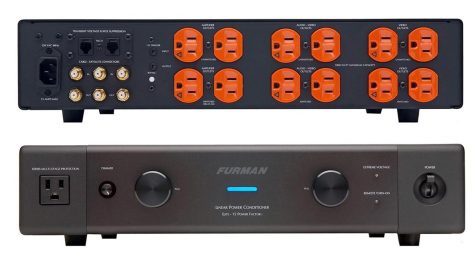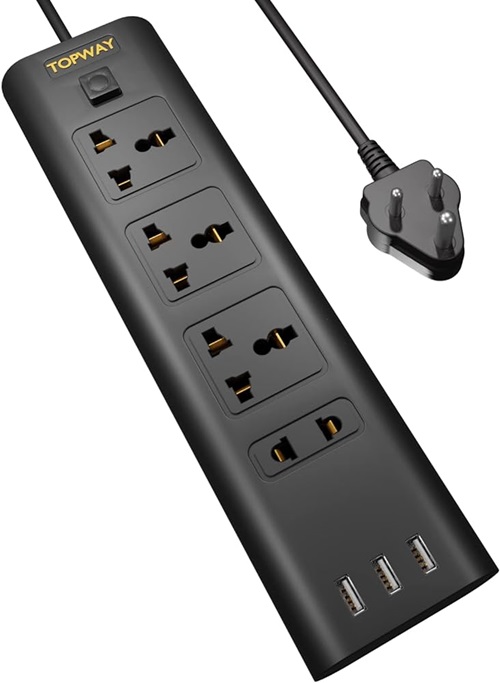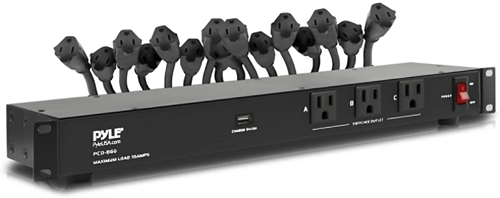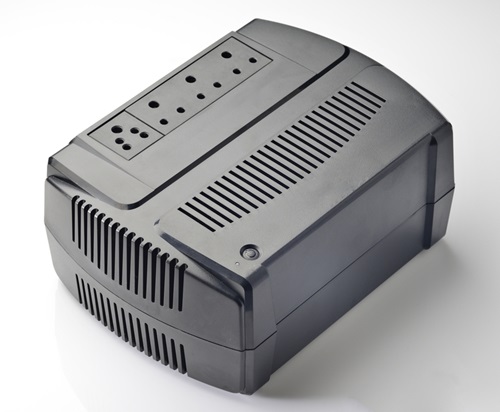With the emerging trends and technologies in media and entertainment, everyone desires to experience an amusing cinematic feel in the comfort of their living environment. However, home theater systems have been ruling the auditory world to elevate your aural experience to the next level.
Well, entertainment is fine but have you ever thought about the safety of your equipment? No wonder…. Similar to other electrical (or) electronic devices even home theatre systems must be safeguarded against dirty electricity, lightning strikes, voltage fluctuations, and power outages. That is where the power managers come into the light. Home theatre power managers are particularly engineered to protect your home theater systems from various power issues. Now your brain might be packed with too many questions. Worry not, we have covered all your concerns, doubts, and questions in this article.
In this comprehensive article, we will go through various topics that are listed below in the table. Simply have a glance at the contents for your reference.
Now, getting back into the details, primarily, let’s start with what is a home theater power manager. And Do you need one for your home theater too?
Outline
Toggle- What is a Home Theatre Power Manager?
- Do You Really Need a Home Theater Power Manager?
- Different Types of Home Theater Power Managers
- Benefits of Home Theatre Power Managers
- Drawbacks of Home Theatre Power Managers
- How to Choose the Best Home Theatre Power Manager?
- How to Properly Use and Maintain A Home Theatre Power Manager?
- How can I maximize performance from my home theater power manager?
- Home Theatre Power Manager – FAQs
- Conclusion
What is a Home Theatre Power Manager?

It includes the following features such as
- The capacity to turn off the components that are not in use.
- The ability to schedule when the components have to turn on (or) turn off.
- The potential to monitor and control the power usage of various components in a home theater system.
- The efficiency to convert “dirty” power into clean, pure, steady, and noise-free electricity.
Typically, most of the home theater power manager modules look identical to DVD (or) Blu-ray Players. However, if you flip it around, you will notice multiple separate outlets into which you can plug in various devices easily. These outlets also protect against spikes, surges, noise, and other anomalies that may harm sensitive equipment.
At present, many power managers are equipped with advanced features such as Automatic Voltage Monitoring, which tracks and regulates incoming AC voltage for over-voltage, under-voltage, quick spikes, and so on. If the power manager detects “unsafe” voltage levels, it disconnects the device and reconnects only after safe voltage levels are restored.
Do You Really Need a Home Theater Power Manager?
There is no easy answer to this. However, the decision to choose a home theater power management is completely determined by the needs of your individual and desired level of security and convenience for the home theater system. But genuinely power managers are an excellent investment for any home theater system because of several advantages they provide, including device protection, power stability, noise reduction, and controlled power distribution.
Looking at the other side of the coin, in most cases, a power management system is unnecessary if your home already has an excellent electrical installation with high-quality components and appliances.
However, if you happen to live in an area where lightning strikes, power fluctuations, or surges occur frequently, then we highly recommend investing in an efficient home theater power manager.
Different Types of Home Theater Power Managers
Typically, home theater power managers are broadly classified into various types based on their features, usage purpose, specifications, etc. Anyways, here is the list of some popular power managers available in the market.
1. Basic Power Strip

The main purpose of this appliance is to provide numerous outlets for plugging in various devices of your home theater components. It comes with surge protection but does not have advanced power management features.
2. Power Conditioner
Power conditioners are primarily designed to smooth out voltage fluctuations as well as radio and electromagnetic interference, both of which can have an impact on system performance.
It also has surge protection, as well as noise filtration and voltage control, to deliver a cleaner power supply to your equipment while minimizing audio and video interference.
3. Battery Backup
A backup battery, often known as a UPS (Uninterrupted Power Supply), supplies electricity to a system when the primary source of power is unavailable.
During power outages, this backup unit switches between a main power supply and the battery to keep processors, monitors, and other equipment powered for a few minutes. It not only safeguards your equipment from power outages but also provides surge protection and voltage control.
4. Smart Power Manager
A smart power manager connects to your home automation system and allows you to remotely control and monitor your home theater power settings. It has advanced features such as energy monitoring, scheduling, and personalized power sequencing.
Benefits of Home Theatre Power Managers
It’s worth it for anyone who is planning to purchase a power manager for their home theater because of its compelling features and benefits. Therefore, we have listed out some of the major advantages of investing in a home theater power manager.
1. Protection from Dirty Electricity
Usually, minor fluctuations in line voltage do not cause abrupt equipment failure (or) burning, but they do have a significant effect on all appliances, progressively destroying them. When you turn on additional appliances (or) merely the lights, you may have observed your appliances buzzing. This is known as filthy electricity. The home theater power manager removes such a signal and delivers clear sound, resulting in clean electricity.
2. Surge Protection
Lightning strikes, utility grid fluctuations, and electrical problems can all cause power surges. This is especially true for persons who live in areas prone to lightning strikes, frequent power outages, sudden drops, or whose house wiring is not of high quality. In this case, surge protection technology in home theater power management protects your equipment from voltage spikes. They direct excess energy away from your equipment, preventing it from being damaged.
3. Noise Reduction
Even though you are confident in the quality of your home’s electricity and have never experienced power fluctuations, you may still hear a humming sound from your speakers. It is because the amplifier detects and broadcasts any low-level noise in the electrical circuitry via the speakers. In this situation, the power conditioner also serves as a filter to improve the sound of your system. However, it is vital to take the time to choose a device because some perform the job too well, and you may miss out on the dynamics of your sound.
4. Equipment Protection
Home theater power management safeguards your pricey audio and visual equipment against power surges, voltage fluctuations, and electrical noise, guaranteeing that your electronics are not damaged. Power managers help to extend the life of your equipment and save you money on costly repairs (or) replacements by preserving it.
5. Environmental Impact
Most home theater power managers nowadays are made of eco-friendly materials and have a good influence on the environment. By carefully monitoring electricity use and avoiding energy waste, this device can help you live a greener lifestyle. Energy conservation minimizes greenhouse gas emissions and encourages sustainability, making your home theater setup more ecologically friendly.
6. Improved Performance
Power managers efficiently filter out electrical noise, increasing the quality of audio and visual transmissions. With this, you can enjoy better sound quality, more precise images, and a more immersive viewing experience with cleaner power.
7. Enhanced Lifespan
Getting the right power management system can help your home theater equipment last longer. Usually, the power managers ensure that devices are turned on and off appropriately, improving durability, reducing wear and tear on the components, and maintaining the performance of your equipment.
8. Cost Savings
Although the initial investment in a home theater power manager is expensive, it may result in significant cost savings over time. It helps in the reduction of electricity costs by correctly managing power utilization and lowering standby power consumption. This is particularly beneficial for people who have large home theater systems with power-hungry components. You may save money in the long term by optimizing electricity use.
Drawbacks of Home Theatre Power Managers
Along with the advantages one must also consider the drawbacks which are as follows.
1. Pricing
High-quality home theater systems are already expensive, and adding power management to them might be an added cost. Furthermore, the cost of the gadget, particularly complex ones with several functions, may influence your budget.
2. Compatibility
It is very important to choose a home theater power manager that is compatible with your present equipment. Usually, different components have different power requirements and particular connectivity requirements such as wired and wireless. That’s why verifying compatibility is critical for seamless integration.
3. Limited Outlets
Power managers often come with numerous outlets. However, the outlet number may vary depending on the model you purchase. If your home theater system has a large number of devices, then you need to look for the model that has minimum outlets to accommodate your devices (or) employ power strips in combination with the power manager for extended connectivity.
4. Maintenance
A home theater power management, like any other electrical equipment, requires frequent maintenance or firmware upgrades to guarantee optimal performance. To optimize the device’s benefits, keep up with maintenance duties, and remain updated about any upgrades or new features.
How to Choose the Best Home Theatre Power Manager?
There are a few factors to bear in mind while selecting a Home Theatre Power Manager. Firstly, start with checking the type of home theatre system you have like do you have a huge home theater with multiple components (or) you just have only one component? Well, look over the other factors to consider before purchasing a home theater power manager that is listed below.
| Size | Consider the size of your home theater system while purchasing a power management system that goes well with it.
Typically, power managers come in varied sizes and also have different features and capabilities based on the type of model you choose. Certainly, high-end power managers come with advanced features such as a remote control and a sleep timer that are not available on low-end variants. So, if you are having (or) planning to buy a high-end home theater system then look for a feature-rich power manager. |
| Power Outlets | Check the number of accessible power sockets when purchasing a home theatre power manager.
If your home theater system has multiple components, choose a power manager with many power outlets to support them; otherwise, if your home theater has less equipment, choose one with fewer outlets. However, most HTPMs now contain multiple power connectors, allowing them to be connected to many devices at the same time. Moreover, some also come with built-in wall outlets for easy installation. |
| Power Adapter | Power adapters should always be considered when choosing a home theater power management.
A good adapter can ensure that all of your gadgets are powered and that the power is stable. It is also important to verify that the adapter you choose is compatible with your devices. Some adapters have numerous ports, whereas others just have one. |
| Surge Protectors | A power manager with an integrated surge protector can help protect your gadgets from voltage spikes.
As a result, when purchasing a power manager, examine the amount of protection given by the power management against power interruptions, as well as whether it has a built-in surge protector (or) not. |
| Noise Reduction | Prioritize power managers with strong power filtering and noise reduction functions to obtain the finest audio and video quality.
Look for devices with numerous filtering stages, such as segregated banks (or) individual outputs. This decreases electrical noise, electromagnetic interference (EMI), and radio frequency interference (RFI) while preventing power contamination between components. Cleaner power supply results in improved performance. |
| Energy Monitoring | Some power managers include energy monitoring capabilities, allowing you to track individual device power use.
This function gives real-time energy use statistics, allowing you to identify energy-hungry components and make informed decisions to maximize power efficiency. Consider if energy monitoring is important to you before selecting a power management system. |
| Compatibility | Make sure the power management works with the gadgets and technology in your home theater setup.
Check the power manager’s supported plug types and make sure they match the plugs on your devices. Consider any communication protocols that your devices require, such as Wi-Fi (or) Bluetooth connectivity. Compatibility is critical for ensuring smooth integration and operation. |
| Build-In Quality and Warranty | Always select models that are composed of high-quality materials to ensure durability and endurance.
A well-built power manager will endure the demands of your home theater system and deliver consistent performance over time. Additionally, look into the manufacturer’s warranty. A robust warranty protects your investment and ensures the quality of the goods. |
| Reviews and Brand | Refer to the user reviews before purchasing a home theatre power manager and even the reputation of the manufacturer (or) brand.
Reading reviews from other customers can offer valuable insights into the reliability and performance of the power manager. Look for feedback on factors such as durability, ease of use, and customer support on various online stores and web platforms. A reputable manufacturer with positive reviews enhances the likelihood of a satisfying purchase. |
How to Properly Use and Maintain A Home Theatre Power Manager?
Now, let’s go into the key steps for efficiently operating and maintaining your home theater power manager.
| Regular Cleaning
Clean your home theater power management on a regular basis to ensure optimal performance. Use a soft, lint-free cloth to clean dust and dirt from the surface. Often, check to ensure that no vents (or) fans are obstructed and that no power lines (or) connections are broken (or) frayed. |
| Power Manager Installation
Set up your power manager according to the instructions provided in the user manual. Configuring parameters such as voltage thresholds, surge protection sensitivity, and energy-saving features can be done accordingly to meet your needs. |
| Right Placement
Choose a suitable location for your power manager. Ensure it is easily accessible and well-ventilated to prevent overheating. Avoid placing it near sources of heat (or) in direct sunlight. Usually, a cool and dry environment is ideal for optimal performance. |
| Know the Device
Before you begin using your home theatre power manager, take the time to read the user manual thoroughly. It will provide you with important instructions specific to your model. Familiarize yourself with the features, installation process, and any safety precautions. |
| Power On/Off Sequence
Follow the detailed instructions when turning on (or) off your home theater system. Begin by enabling the power manager and allowing it to stabilize. Then, one by one, turn on your audio and visual components. When closing down, go backward, turning off your equipment before the power management. |
How can I maximize performance from my home theater power manager?
Here are some tips and recommendations to help you get the most out of your home theater power manager.
- Maintenance: Clean the power manager on a regular basis and examine the power cables for damage. To guarantee a safe and dependable connection, replace any worn-out wires.
- Update Firmware: If your power manager includes firmware capabilities, check for updates and apply them on a regular basis to keep your device up to date.
- Modes of Energy Conservation: Use your power manager’s energy-saving modes to decrease power usage during idle or standby times.
- Proper Ventilation: Ensure the power management has adequate ventilation to avoid overheating. Avoid putting it in confined locations (or) obstructing vents.
Home Theatre Power Manager – FAQs
Ans: Although a power strip has several outlets, it does not give the same level of surge safety and voltage control as specialized power management. A power manager is suggested for comprehensive equipment protection.
Ans: It is not required to switch off your power manager while it is not in use. It may remain connected to the power supply indefinitely to offer continuous surge protection and voltage regulation.
Ans: Power managers save energy by reducing standby power consumption and optimizing power usage. They achieve this through features such as power scheduling, power detection, master/slave outlets, energy monitoring, and smart power strips. By implementing these energy-saving measures, power managers help reduce electricity bills and contribute to a more sustainable and environmentally friendly home theatre setup.
Ans: Most home theater gadgets, including TVs, audio systems, game consoles, and media players, are compatible with power management. However, it is recommended that you review the power manager’s specs and compatibility list to confirm that it supports the devices you want to connect.
Ans: If your power manager detects a surge, turn off your equipment and disconnect the power manager immediately. Inspect the linked devices for evidence of damage and follow the manufacturer’s instructions.
Ans: No, most power managers are meant to be simple to install and do not need expert assistance. They usually come with simple instructions, and you may plug your gadgets straight into the power manager’s outlets. However, it is important to adhere to the manufacturer’s instructions and safety measures during installation.
Ans: Yes, many power managers provide remote management, allowing you to monitor and operate your home theater system from anywhere. You can control and manage everything with a single tap through a web app (or) mobile app (or) integration with home automation systems.
Conclusion
To summarize, purchasing a home theater power management is essential for protecting your precious audio and video equipment, improving performance, and extending the life of your gadgets. A power manager offers a consistent and clean power supply for your home theater system by controlling power and offering surge protection, voltage management, and other sophisticated features.
Choose a power management system that meets your requirements, taking into account variables such as surge protection, voltage regulation, noise filtration, and smart features. Proper installation, frequent maintenance, and troubleshooting may help your power manager work even better. To improve your entertainment experience, upgrade your home theater system with a dependable and efficient power manager.



